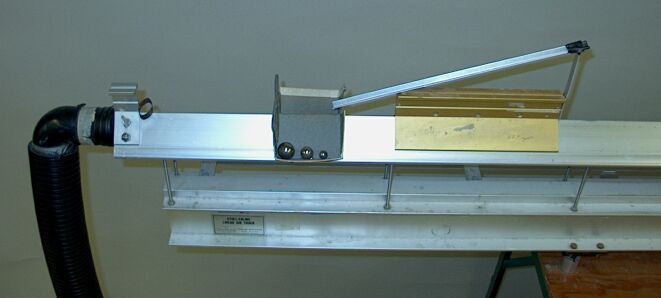
Set one of the steel balls at the top of the ramp on the glider, and release it. As the ball rolls down the ramp to the left, the glider accelerates to the right. The larger the ball you use, the greater the acceleration.
This demonstration provides an illustration of Newton’s third law of motion, which states (as quoted in Resnick, Robert and Halliday, David. Physics, Part 1, Third Edition (New York: John Wiley and Sons, 1977), p. 79) To every action there is always opposed an equal reaction; or, the mutual actions of two bodies upon each other are always equal, and directed to contrary parts. It is similar to demonstration 12.63 -- Roll dumbbell down skateboard ramp, in which you roll a dumbbell down a ramp that rests on a skateboard. The horizontal component of the normal forces between the dumbbell and the ramp, causes them to accelerate in opposite directions. Here, in place of the skateboard we have an air track glider with a ramp affixed to it, down which you roll a steel ball. Except that the dumbbell and skateboard with ramp roll, and the steel ball rolls and the glider glides (i.e., is not held by friction), these systems are similar to a block on an inclined plane (demonstration 12.69 -- Slide blocks down incline).
In pulling the steel ball downward against the ramp, gravity causes the ball to exert a force on the ramp, which in turn exerts an equal and opposite force on the ball. This force has two components, one perpendicular, or normal, to the top face of the ramp (= mg cos θ, where m is the mass of the steel ball, and θ is the angle of the ramp above horizontal), and one parallel to the ramp (= mg sin θ). Except for friction, the ramp cannot exert a force on the steel ball parallel to its face. The normal force, however, has a horizontal component, (mg cos θ) sin θ, which the steel ball and the ramp exert on each other. When you place the steel ball at the top of the ramp and then release it, as it rolls down the ramp, the glider accelerates in the opposite direction to that of the rolling ball. The ball rolls into the catcher at the bottom of the ramp, while the glider travels down the air track in the opposite direction. The acceleration of gravity is constant, but the forces that the steel ball and the glider exert on each other depend on the mass of the steel ball. That the balls roll introduces some subleties into the behavior of the system. Still, the greater the mass of the steel ball released down the ramp, the greater the horizontal forces, and the greater the speed of the glider as it travels down the air track.